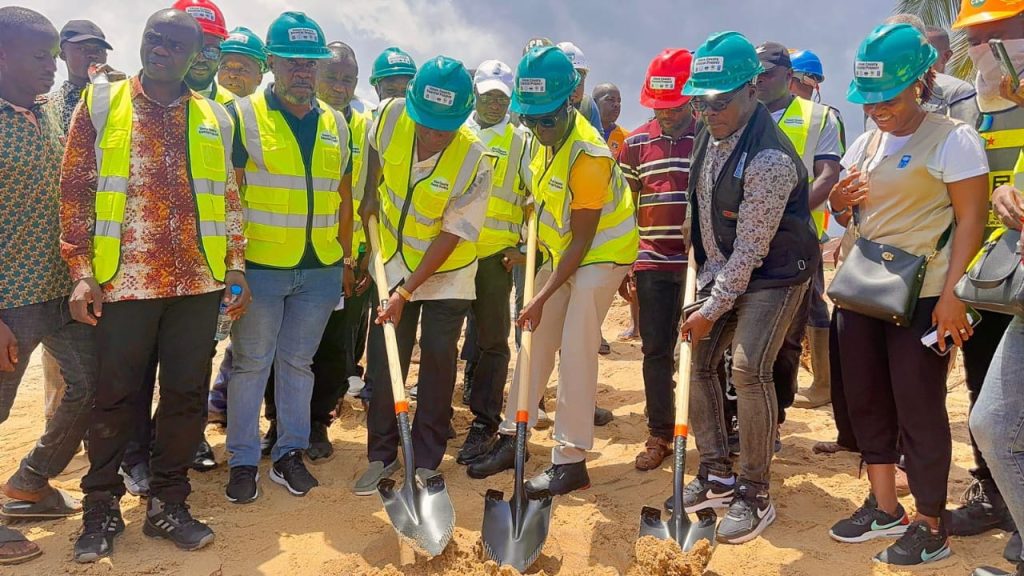The Liberian government, in partnership with the Global Environment Facility (GEF) and the United Nations Development Programme (UNDP), has embarked on a significant initiative to bolster the resilience of its vulnerable coastal communities against the escalating threats of climate change. This ambitious undertaking, known as the Sinoe Coastal project, represents an $8.9 million investment aimed at mitigating the devastating impacts of coastal erosion in Sinoe County, a region grappling with the immediate consequences of rising sea levels. The project, officially launched by the Environmental Protection Agency (EPA), falls under the umbrella of UNDP Liberia’s Energy & Environment Programme Inclusive Green Growth Portfolio. This broader program emphasizes a multi-faceted approach to safeguarding vulnerable communities, encompassing the construction of hybrid adaptation infrastructure such as coastal revetments, the development of resilient livelihoods, and enhanced access to critical climate information.
The project’s groundbreaking ceremony in Sinoe County served as a platform for collaboration, bringing together a diverse array of stakeholders, from national government representatives and local authorities to traditional leaders and community residents. This collaborative spirit underscores the project’s emphasis on community participation and ownership, recognizing that local knowledge and engagement are crucial for its long-term success. The ceremony also provided an opportunity to address key challenges, including communication gaps with local stakeholders, existing political and tribal tensions, and community demands for compensation related to project activities. The EPA Executive Director, Dr. Urey Yarkpawolo, acknowledged these complexities, highlighting the successful negotiation of a goodwill compensation agreement with the Bana community, home to a sacred rock quarry site affected by the project. This agreement, coupled with extensive community engagement meetings, marked a significant turning point, solidifying community support for the project’s objectives.
The Sinoe Coastal project signifies more than just infrastructural development; it embodies a commitment to sustainable development, climate action, and community empowerment. It underscores Liberia’s recognition of its unique environmental position as a biodiversity hotspot while acknowledging the socio-economic vulnerabilities of its coastal populations. With sea level rise posing an imminent threat, projected to displace over 230,000 people and cause $250 million in land losses, the project’s focus on immediate and impactful action is both timely and critical. The initiative aims to equip communities with the tools and resources necessary to adapt to the changing climate, fostering resilience and enabling them to thrive despite the challenges. This includes empowering women and youth, recognizing their vital roles in community development and adaptation strategies.
Dorsla Farcarthy, UNDP’s Team Lead for the Inclusive Green Growth Portfolio, characterized the project as a beacon of resilience, unity, and forward-thinking. The project’s holistic approach integrates environmental protection with community empowerment, ensuring that the benefits of climate resilience extend beyond physical infrastructure to encompass the social and economic well-being of the local population. This integrated approach reflects a growing understanding that climate change adaptation requires not only physical defenses against environmental changes but also the strengthening of social and economic systems to withstand and recover from climate-related shocks. The project’s success hinges on effective stakeholder coordination, transparency in resource allocation, and ongoing community engagement.
Community residents and local leaders, playing an integral role in the project’s implementation, have emphasized the need for strengthened stakeholder coordination, transparent recruitment practices for local labor, and secured resources for continued community engagement. These recommendations underscore the importance of local ownership and participation in ensuring the project’s effectiveness and sustainability. Addressing these concerns proactively will be crucial in preventing project delays and fostering a sense of shared responsibility for the project’s outcomes. The Sinoe Coastal project serves as a pilot initiative, with plans to expand its reach to other vulnerable coastal counties in Liberia. This expansion demonstrates the Liberian government’s commitment to scaling up climate adaptation efforts and integrating resilience-building into its national development agenda.
The Sinoe Coastal Project represents a critical step in Liberia’s journey towards sustainable development and climate resilience. It demonstrates the power of partnership, bringing together international organizations, government agencies, and local communities to address a shared challenge. The project’s comprehensive approach, integrating infrastructural development, livelihood enhancement, and community empowerment, offers a valuable model for other countries facing similar climate change threats. As the project unfolds, its successes and challenges will provide valuable lessons for future climate adaptation initiatives, both within Liberia and beyond its borders. The international community will be watching closely, eager to learn from Liberia’s experience in building resilient coastal communities in the face of a changing climate. The project’s long-term impact will depend on the continued commitment of all stakeholders, working together to ensure that vulnerable coastal communities are equipped to navigate the challenges of climate change and build a more sustainable future.


